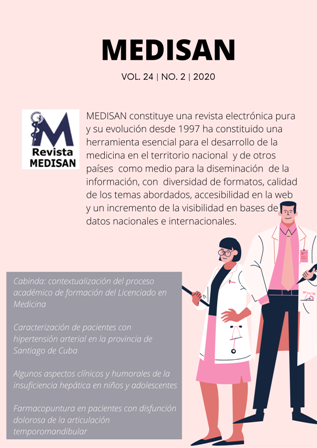Some clinical and humoral aspects of liver failure in children and adolescents
Keywords:
child, adolescent, acute liver failure, brain disease, hepatotropic virus.Abstract
Introduction: The acute liver failure is an entity of multifactorial origin that is presented in previously healthy children and has direct repercussion in the synthesis, clotting and purification functions.
Objective: To characterize children with acute liver failure according to clinical and humoral variables.
Methods: A retrospective and descriptive study of 19 patients with diagnosis of acute liver failure was carried out, they were assisted in the Pediatric Intensive Cares Unit of the Southern Children Hospital in Santiago de Cuba, from April, 1998 to the same month in 2018, for which theoretical and statistical methods were used.
Results: In the case material there was a prevalence of the female sex (57.9 %), the mean age was 5 years and the infection constituted the most common cause (73.7 %). The hepatotropic virus as the hepatitis A were the most frequent. The complications of more observance were the respiratory alkalosis (63.1 %), the multiorganic dysfunction (42.1 %) and the liver brain disease (31.6 %). The low figures of cholesterol and the prothrombin time higher than 20 seconds were associated with a greater lethality.
Conclusions: In the patients younger than one year the non hepatotropic virus constituted the most frequent origin in this disease.
Downloads
References
2. Salim Shakur MD. Illustrated Textbook of Pediatrics. 2ed. India: Jaypee Brothers Medical Publishers; 2015. p. 282-8.
3. Dias Costa F, Moinho R, Ferreira S, Garcia P, Diogo L, Goncalves I, et al. Fallo hepático aguda asociado a enfermedades metabólicas hereditarias en niños pequeños. An Pediatr (Barc). 2018 [citado 08/01/2019]; 88 (2): 69-74. Disponible en: https://www.sciencedirect.com/science/article/pii/S1695403317300784
4. Roque J, Ríos G, Pinochet C, Vignolo P, Humeres R, Ríos H, et al. Falla hepática fulminante en niños. Rev. chil. pediatr. 2009 [citado 08/01/2019]; 80 (2): 144-9. Disponible en: https://scielo.conicyt.cl/scielo.php?script=sci_arttext&pid=S0370-41062009000200006&lng=es
5. Infante Velázquez M. Insuficiencia Hepática Aguda. Rev Cub Med Mil. 2001 [citado 08/01/2019]; 30 (supl. 5): 63-70. Disponible en: http://scielo.sld.cu/scielo.php?script=sci_arttext&pid=S0138-65572001000500011&lng=es
6. Ciocca M, Costaguta A, Cuarterolo M, Delgado L, Garcete L, Godoy M, et al. Insuficiencia Hepática Aguda Pediátrica. Grupo de Trabajo de la Sociedad Latinoamericana de Gastroenterología, Hepatología y Nutrición Pediátrica. Acta Gastroenterol Latinoam. 2016 [citado 14/01/2019]; 46 (1): 52-70. Disponible en: http://actagastro.org/insuficiencia-hepatica-aguda-pediatrica-grupo-de-trabajo-de-la-sociedad-latinoamericana
7. Alonso EM, Horslen SP, Behrens EM, Doo E. Pediatric acute liver failure of undetermined cause: A research workshop. Hepatology. 2017 [citado 14/01/ 2019]; 65 (3): 1026-37. Disponible en: https://www.ncbi.nlm.nih.gov/pubmed/27862115
8. Silverio CE, Smithen Romany CY, Hondal NI, Díaz HO, Castellanos MI, Sosa O. Insuficiencia hepática aguda en niños cubanos. Rev MEDICC. 2015 [citado 26/01/2019]; 17 (1):1-8. Disponible en: http://mediccreview.org/wp-content/uploads/2018/04/mr_541_es.pdf
9. Reyes Cerecedo A, Flores Calderón J, Villasis Keever MA, Ortiz Galvan RC, Jean Aurelus P, Cuervo Moreno E, et al. Consenso para el manejo de la falla hepática aguda en pediatría. Rev Mex Pediatr. 2017 [citado 14/01/2019]; 84 (3): 120-8. Disponible en: www.medigraphic.com/pdfs/pediat/sp-2017/sp173g.pdf
10. Keeffe EB. Insuficiencia hepática aguda. Rev Gastroenterol Mex. 2005 [citado 14/01/2019]; 70 (1): 57-64. Disponible en: www.medigraphic.com/pdfs/gastro/ge-2005/ge051i.pdf
11. García Romero R, Martín de Carpi J, Bernal Cuartas C, Pinillos Pisón S, Varea Calderón V. Hepatitis autoinmune en la edad pediátrica. Rev. esp. enferm. dig. 2007 [citado 8/01/2019]; 99 (5):1-10. Disponible en: http://scielo.isciii.es/scielo.php?script=sci_arttext&pid=S1130-01082007000500002&lng=es&nrm=iso&tlng=es
12. Gilbert Pérez JJ, Jordano Moreno B, Rodríguez Salas M. Etiología, resultados e indicadores pronósticos del fallo hepático agudo pediátrico. An Pediatr (Barc). 2018 [citado 8/01/2019]; 88 (2): 63-8. Disponible en: https://www.sciencedirect.com/science/article/pii/S169540331730084X
13. Jain V, Dhawan A. Prognostic modeling in pediatric acute liver failure. Liver transplantation. 2016 [citado 25/01/2019]; 22 (10):1428-30. Disponible en: https://aasldpubs.onlinelibrary.wiley.com/doi/epdf/10.1002/lt.24501
14. Ospitaleche M, Lagomarsino G, Pinchak C. Actualización de hepatitis autoinmune en pediatría. Reporte de un caso clínico y revisión de la literatura. Arch. Pediatr. Urug. 2016 [citado 25/01/2019]; 87 (2):1-19. Disponible en: http://www.scielo.edu.uy/scielo.php?script=sci_arttext&pid=S1688-12492016000200007
15. Shneider BL, Suchy FJ. Autoimmune Hepatitis. In: Kliegman RM, Stanton BF, Schor NF, Geme J, Behrman RE. Nelson Texbook of Pediatrics. 20ed. Philadelphia: Elsevier/Saunders; 2015. p.1961-64.
16. Kaur S, Kumar P, Kumar V, Kumar Sarin S, Kumar A. Etiology and prognostic factors of acute liver failure in children. Indian Pediatrics. 2013 [citado 25/01/2019]; 50: 677-9. Disponible en: https://www.indianpediatrics.net/july2013/july-677-679.htm
17. Pérez Guerra V, Ramírez Cardona L, Yepes Grajales OM, Vélez Rivera JD, Marín Zuluaga JI. Falla hepática aguda sobre crónica. Rev Col Gastroenterol. 2016 [citado 16/01/2019]; 31 (3):262-72. Disponible en: http://www.scielo.org.co/scielo.php?script=sci_arttext&pid=S0120-99572016000300010&lng=en
18. Castilla Valdez MP, Méndez Rodríguez Y, Palacios Saucedo GC. Evolución de los pacientes pediátricos con trasplante hepático (TH) en un hospital de tercer nivel del noreste del país. Gac Méd Méx. 2014 [citado 16/01/2019]; 150 (3):282-7. Disponible en: https://www.medigraphic.com/pdfs/gaceta/gm-2014/gms143c.pdf
19. Farias JA, Neira P, Koch E, Nieva AM. Guías de Terapia Intensiva Pediátrica. Argentina: Corpus; 2015.
Published
How to Cite
Issue
Section
License
All the articles can be downloaded or read for free. The journal does not charge any amount of money to the authors for the reception, edition or the publication of the articles, making the whole process completely free. Medisan has no embargo period and it is published under the license of Creative Commons, International Non Commercial Recognition 4.0, which authorizes the copy, reproduction and the total or partial distribution of the articles in any format or platform, with the conditions of citing the source of information and not to be used for profitable purposes.






